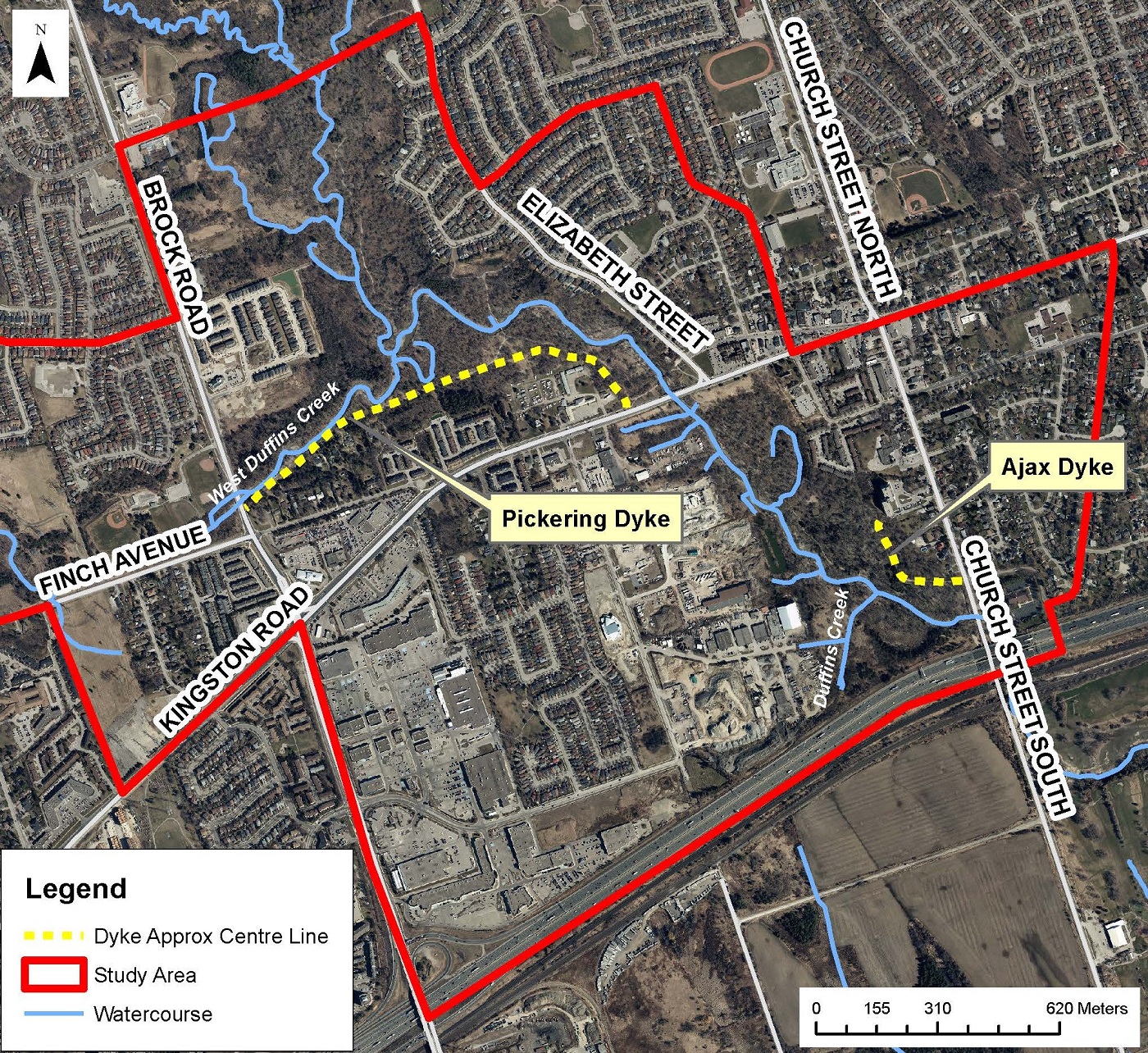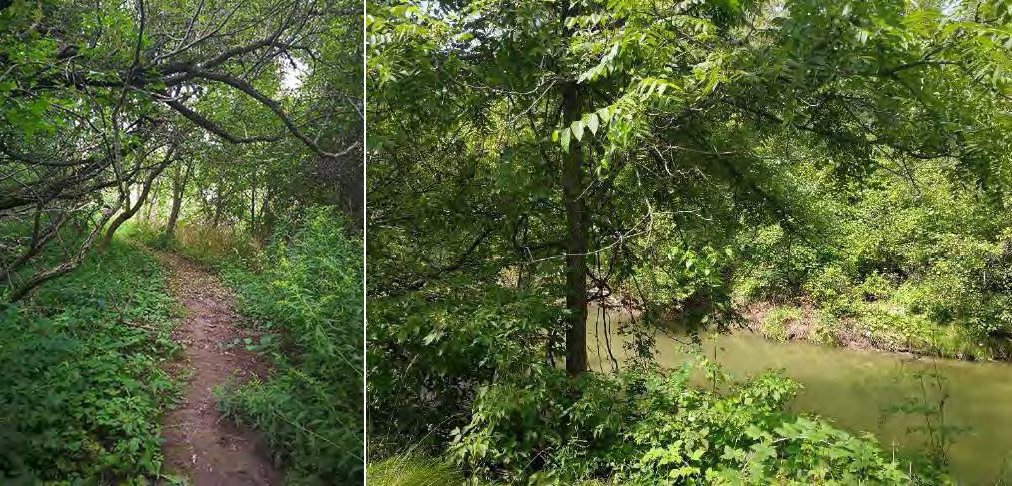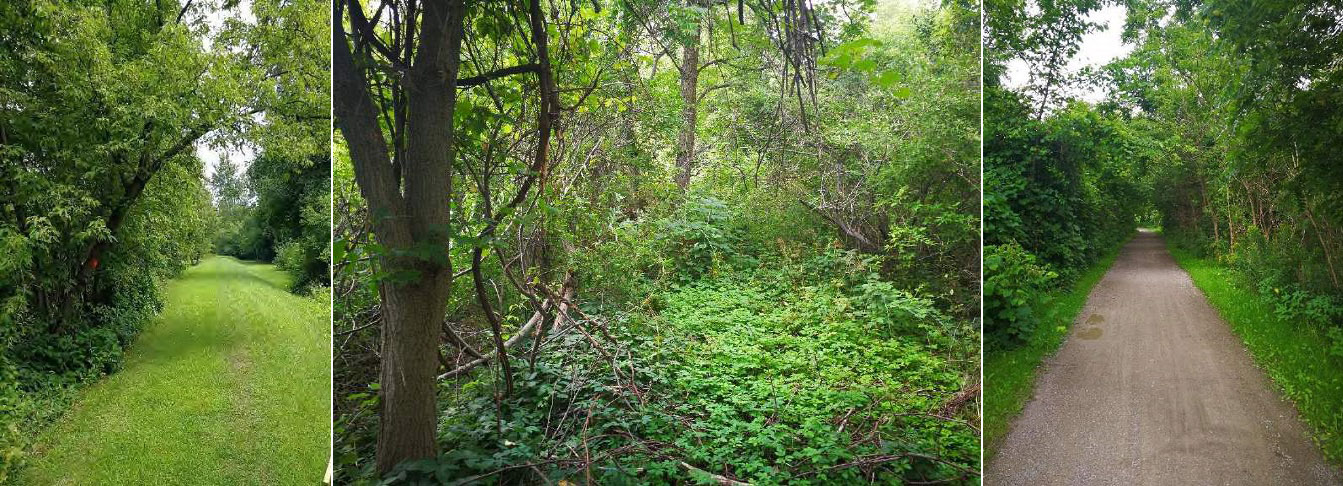Toronto and Region Conservation Authority (TRCA) has undertaken a Conservation Ontario Class Environment Assessment (EA) for Remedial Flood and Erosion Control Projects for the study of rehabilitation options for two (2) existing flood control dykes referred to as the Pickering and Ajax dykes.
The dykes were constructed in the 1980s to provide flood protection for the Village East community in Pickering and the Notion Road/Pickering Village community in Ajax, which are both designated Special Policy Areas (SPA)*.
Recent studies completed by TRCA have identified various deficiencies in their construction which prevent them from meeting current engineering design standards and factors of safety (FOS). As such there is a risk of dyke failure under an extreme storm event.
It is desired to undertake rehabilitation of the dykes to meet current engineering standards and FOS, while maintaining or improving the level of flood protection provided to the surrounding communities (at minimum maintain the level associated with the existing dyke heights).
*A Special Policy Area (SPA) is an area within a community that has historically existed in the floodplain and where site-specific Provincial policies are intended to provide for the continued viability of existing uses.
LATEST PROJECT NEWS
This Class EA project has been completed and approved. The next step is to complete the detailed design of the dyke rehabilitation and prepare construction plans. TRCA is actively seeking funding from various government partners for this next step.
PROJECT PROGRESS
| August 8, 2019 Notice of Project Commencement |
 |
| Summer 2019 Baseline Inventory, Problem & Opportunity |
 |
| Fall 2019 Alternative Solutions |
 |
| December 5, 2019 Public Information Centre #1 |
 |
| Winter 2019 Design Concepts for Preferred Solution |
 |
| April 28, 2020 Public Information Centre #2 |
 |
| Spring 2020 Environmental Study Report |
 |
| Late Summer 2020 Report Available for Public Review |
 |
| Fall 2020 Anticipated Approval of EA |
 |
The Pickering and Ajax Dykes Rehabilitation Project is following the Class Environmental Assessment process for Remedial Flood and Erosion Control Projects outlined by Conservation Ontario.
![]() – Marks points of public consultation.
– Marks points of public consultation.
PROJECT BACKGROUND
The Village East and the Notion Road Pickering Village communities in the City of Pickering (Ward 3) and Town of Ajax (Ward 1) are located within the regulatory floodplain of the Duffins Creek watershed. This area has a long history of flooding, with 634 buildings susceptible to flooding during a Regional Storm (Hurricane Hazel) event.
Due to the flood vulnerability of the community, the area was designated as a Special Policy Area (SPA) to provide for the continued viability of existing land uses. In addition, flood protection measures were constructed in the 1980s to provide flood protection up to and including the 500-year storm flow.
The flood protection measures consisted of two flood protection dykes:
- The Pickering Dyke, constructed in 1985, extends for approximately 1,150 metres, and is located north of Kingston Road extending from Brock Road eastward to east of Notion road.
- The Ajax Dyke, constructed in 1984, extends for approximately 325 metres, and is located west of Church Street South extending north from near Mill Street.

As part of TRCA’s flood control program, these dykes have been inspected annually and after every significant rain event. In 2007, a major erosion scar was identified and repaired in 2008.
In 2009, TRCA undertook a detailed assessment and “level of service” study of the dykes and adjacent creeks in order to develop a permanent long-term solution to address erosion issues.
In response to the recommendations from the 2009 study and in order to update flood modelling for the area, TRCA completed a multi-faceted study of the Pickering and Ajax SPAs and dykes in 2018. The objectives of the study were to:
- Develop a more advanced hydraulic model of the area to characterize flood risks within the SPA
- Assess the level of service and structural competency of the Pickering and Ajax flood control dykes
- Develop a preliminary restoration strategy for the dykes
Based on the results from the 2018 hydraulic modelling study, it was determined that the targeted level of flood protection to the 500-year event is not provided by the existing flood control dykes. The Pickering Dyke provides flood protection for the 100-year storm and the Ajax Dyke provides flood protection for the 50-year storm.
Factors contributing to the reduced level of flood protection afforded by the Pickering and Ajax Dykes include: reduced dyke elevations due to settlement, and less sophisticated hydraulic modeling methods used as part of the original design process.
The Dyke Level of Service and Rehabilitation Report (2018) identified a number of deficiencies for both the Pickering and Ajax dykes based on field and geotechnical investigations. The deficiencies included:
- Excessive vegetation
- Erosion
- Deteriorating dyke toe protection
- Improper dyke construction materials
- Blocked flap gates
- Sediment and debris in culverts
- Slope stability issue
- Settlement/low areas on top of the dykes


The results of the geotechnical stability analysis indicate that the current dykes do not meet current engineering design standards. As such there is a high potential of dyke failure under an extreme storm event.
Nine (9) options to address the structural/slope stability issues and rehabilitate the dykes were developed in the 2018 study.
Due to the scale of the required rehabilitation work, in order to move forward on the rehabilitation plans, the 2018 report recommended that a further study be undertaken by TRCA in accordance with the Conservation Ontario Class EA for Remedial Flood and Erosion Control Projects to assess all potential impacts and refine options for the rehabilitation of the dykes.
The report also recommended that TRCA undertake general repairs and maintenance immediately, prior to initiation of the EA Study, including erosion protection for priority sites and flap gate maintenance. TRCA initiated maintenance and repair work on the dykes in 2018.
At this time TRCA is undertaking a Conservation Ontario Class EA focused on determining the preferred solution for rehabilitation of the existing dykes.
The dyke rehabilitation objective is to provide the same, or greater, level of flood protection as associated with the current height of the dykes (minimum 100-year storm flood protection by the Pickering Dyke and minimum 50-year storm flood protection by the Ajax Dyke) and to enhance the dykes to meet current engineering design standards.
Background Studies
- Preliminary Engineering Report for Flood Protection on the Duffin Creek in Pickering Ajax Area (1982)
- Geotechnical Investigation – Proposed Dyking Duffin Creek (1984)
- Subsurface Investigation – Proposed Dyking Duffin Creek (1985)
- Ajax and Pickering SPA Regulatory Floodplain Mapping Update (2018)
- Dyke Level of Service and Rehabilitation Report (2018) – Available upon request due to large file size. Contact us if you require a copy
- Flood Characterization and Preliminary Remediation Investigation (2018)
MEETING MATERIALS & NOTICES
Notice of Approval
Notice of Filing
Public Information Centre #2: April 28, 2020
- Notice of Public Information Centre #2
- Notice of Public Information Centre #2 Postponement
- Display Boards/Panels
- Presentation
- PIC Video
- Comment/Feedback Form
Public Information Centre #1: October 30, 2019
Notice of Commencement
EA DOCUMENTS
Environmental Study Report: August 27, 2020 – October 26, 2020
- Notice of Filing posted August 27, 2020
- Pickering and Ajax Dykes Rehabilitation Environmental Study Report – Main Report
- Appendix A – Reference Maps from Previous Studies
- Appendix B – Geotechnical Investigation
- Appendix C – Geomorphology Technical Memo
- Appendix D – Natural Environment Investigation
- Appendix E – Stage 1 Archaeological Assessment
- Appendix F – Built Environment Records
- Appendix G – 10% Design Drawings of Alternative Solutions for the Pickering and Ajax Dykes
- Appendix H – Technical Analysis
- Appendix I – Drawings of Design Concept for the Pickering and Ajax Dykes
- Appendix J (part 1) – Record of Consultation
- Appendix J (part 2) – Record of Consultation
CONTACT INFORMATION
Questions? Please contact:
PADR Coordinator
Toronto and Region Conservation Authority (TRCA)
101 Exchange Avenue, Vaughan ON L4K 5R6
Email: info@trca.ca
Website: www.trca.ca/PADR
